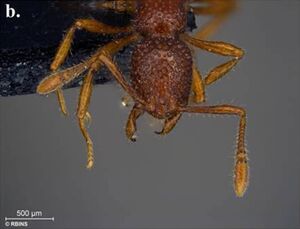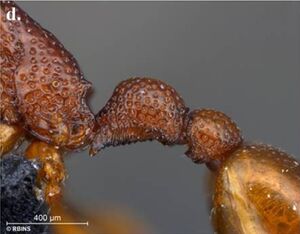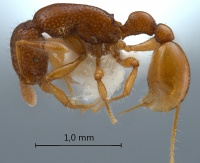Tyrannomyrmex rex
| Tyrannomyrmex rex | |
|---|---|

| |
| Scientific classification | |
| Kingdom: | Animalia |
| Phylum: | Arthropoda |
| Class: | Insecta |
| Order: | Hymenoptera |
| Family: | Formicidae |
| Subfamily: | Myrmicinae |
| Tribe: | Solenopsidini |
| Genus: | Tyrannomyrmex |
| Species: | T. rex |
| Binomial name | |
| Tyrannomyrmex rex Fernández, 2003 | |
This is the only species of this enigmatic genus that is known from more than a few specimens.
Identification
Fernández (2003) - Tyrannomyrmex possesses a unique combination of traits which separate it from other myrmicines: modified setae along the internal border of the mandibles and mandibles with two teeth, apical and subapical, with the rest of the masticatory border lacking teeth. The modified setae are reminiscent of some of the Adelomyrmex (Fernández, 2003), but in Tyrannomyrmex the setae are thick, nonspatulate, and cylindric.
The antennal club is not easily-defined. At first glance it appears to be 2-segmented, but the last segments under careful examination might also be interpreted as 3-segmented.
Keys including this Species
Distribution
Distribution based on Regional Taxon Lists
Indo-Australian Region: Malaysia (type locality), Singapore.
Distribution based on AntMaps
Distribution based on AntWeb specimens
Check data from AntWeb
Countries Occupied
| Number of countries occupied by this species based on AntWiki Regional Taxon Lists. In general, fewer countries occupied indicates a narrower range, while more countries indicates a more widespread species. |

|
Estimated Abundance
| Relative abundance based on number of AntMaps records per species (this species within the purple bar). Fewer records (to the left) indicates a less abundant/encountered species while more records (to the right) indicates more abundant/encountered species. |

|
Biology
The holotype worker collected from a litter sample in peninsular Malaysia. A second specimen was collected: December 2012 in MacRitchie Reservoir, Singapore (N 01°20’30’’, E 103°49’43’’), during a biodiversity survey of the ants from Singapore. It was found in a selectively logged primary forest not exploited for decades, comprising primary forest species at an intermediate stage of regeneration. While the plant species composition was that of a primary forest, it lacked large emergent trees present in adjacent unlogged primary forest. The site was located near an old growth primary forest (Jacquemin et al., 2015).
These were the only known specimens of this species prior to the March 2016 discovery of a colony in a Singapore.
Wong and Yong (2017) - The colony of T. rex was collected by hand in the Mandai area (1.401°N, 103.777°E) of Singapore, which comprises secondary forests, previously managed as orchards (e.g. durian, rambutan, banana) and rubber plantations during the early 1900s. The collection site showed signs of disturbance from regular military training activities – the forest floor was open due to trampling of understory plants and littered with bottles and food wrappings. Discovering T. rex in such habitat indicates that Tyrannomyrmex species are not necessarily “restricted to pristine or relatively undisturbed forests” as previously suggested by Jacquemin et al. (2015).
We found the ants beneath the leaf-litter (removed for Winkler extraction) at the base of a tree (diameter at breast height = 1.2 m). Several workers were clustered on the freshly exposed soil surface, around a small (<15 cm) piece of moist, fibrous rotting wood partially buried in damp soil. No additional conspecifics were found in the surrounding soil upon manual searching, or present in Winkler extractions of leaf-litter samples from the area. When dismantled, the piece of rotting wood revealed two hollow cavities which appeared to be nest chambers harbouring more T. rex workers and brood. At the time of collection, the T. rex colony contained a total of 13 workers (including 1 callow), 2 worker pupae, 1 male pupa, 9 larvae and 5 eggs (some eggs may have been lost).
No nests of other ant species were found in the vicinity of the T. rex colony, nor were there other ants around or inside the T. rex nest. This suggests that Tyrannomyrmex species are not social parasites - a previous speculation by Jacquemin et al. (2015) based on the ants’ supposedly pathogen-rich habitats (i.e. soil and litter), in spite of their puzzling lack of functional metapleural glands for sanitation and chemical defences (i.e., based on the absence of a metapleural gland orifice in T. rex and T. dux specimens examined by Fernández 2003, Borowiec 2007 and Jacquemin et al. 2015; also observed in the T. rex workers from the current collection).
Colony Laboratory Observations - The T. rex colony was transferred into a standard ‘nest tube’ setup comprising a 20 ml glass test tube half-filled with water that was stoppered by a wool plug, and connected to a wider foraging area for the ants of 20 x 15 x 4 cm. A plastic straw (diameter = 4 mm) held in place by wool at the mouth of the nest tube provided a nest entrance.
Activity patterns - Tyrannomyrmex rex is likely nocturnal, based on daily observations throughout the 10 days for which the ants were in captivity, indoors away from sunlight. During daylight hours, all individuals remained clustered within the nest tube with little movement observed, regardless of whether the setup was in the dark or placed under direct artificial lighting. However, at night-time between two to four workers were observed exploring the foraging area in the dark; this activ- ity persisted even when direct artificial lighting was introduced at night. The environmental cues by which T. rex may maintain circadian rhythms are unknown.
Defence - Tyrannomyrmex rex demonstrated a ‘timid’ behaviour: when intimidated - either by nudging with forceps or when encountering invertebrates (e.g. a millipede in Video S1; [1]), the ants typically curled their head and gaster inwards and under their legs and mesothorax, remaining motionless until the “aggressor” moved on, after which the ants quickly moved away (Video S1). Stinging was only observed once in T. rex following significant threat: a millipede crawled into the cluster of T. rex workers and brood within the nest tube, over multiple ‘curled-up’ workers, before being grabbed and stung by one individual (Video S2; [2]).
Cafeteria experiment - The prey of T. rex remains unknown despite numerous attempts to offer a selection of items in the foraging area. Tyrannomyrmex rex workers always antennated items while keeping their distance, and subsequently moved away. This behaviour was consistent for both live and dead prey items offered, including millipedes, centipedes (Geophilomorpha), mites (Oribatida), springtails (Collembola), spiders (Oonopidae), termite workers, workers and brood of other ant species collected from leaf litter at the same site (Carebara, Eurhopalothrix, Hypoponera, Mono- morium, Ponera), and commercial honey. Considering their extremely timid nature, as well as their small, blunt mandibles with little dentition along the basal mandibular and clypeal margins (Fernández 2003), it is conceivable that T. rex are specialised predators of invertebrates which are much smaller than themselves, eggs of other in- vertebrates, or are scavengers.
Tyrannomyrmex rex male - A single male T. rex emerged two days after the colony was collected. Unfortunately, the specimen was completely consumed by its nestmates soon after. Video S3 [3] shows the live male T. rex.
Castes
Worker
    
| |
| . | |
Nomenclature
The following information is derived from Barry Bolton's Online Catalogue of the Ants of the World.
- rex. Tyrannomyrmex rex Fernández, 2003a: 3, figs. 1,2 (w.) WEST MALAYSIA.
- Type-material: holotype worker.
- Type-locality: Malaysia: Negri Sembilan, Pasoh Forest Reserve, xi.1994, no. 312 (M. Brendell, K. Jackson & S. Lewis).
- Type-depository: BMNH.
- Status as species: Alpert, 2013: 287 (in key); Jacquemin, et al. 2015: 276; Sadasivan & Kripakaran, 2017: 275 (in key).
- Distribution: Malaysia (Peninsula).
Unless otherwise noted the text for the remainder of this section is reported from the publication that includes the original description.
Description
Worker
HW 0.60 HL 0.80 EL 0.06 SL 0.64 PrW 0.49 WL 1.06 PL 0.43 PPL 0.29 PW 0.29 PPW 0.31 GL 0.92 TL 3.75 CI 75 SI 106.
Head in full face view longer than wide, with rounded posterolateral corners, and slightly concave posterior margin; sides slightly convex, slightly narrowing anteriorly. Basal mandibular border separated from masticatory border by distinct angle, masticatory border mostly edentate except for two apical teeth, ventral border of masticatory margin with row of thick, modified setae. Palp formula 2,2 in situ count. Anterior margin of clypeus convex, nearly angular medially; posteriorly clypeus projects narrowly between frontal lobes; median portion of clypeus raised and convex in lateral view, not modified as a flattened area and devoid of any carinae. Frontal lobes short and approximate. Antennae 11-segmented, with ill-defined 3-segmented club, the apical segment largest; scapes longer than head width, slightly incrassate subapically. Scape, when placed back, fails to reach the vertex margin by less than its maximum diameter. Eyes small, with a few ill-defined facets (about 6–7), situated slightly anterior to midlength of sides of head. Mesosoma forming a single broad and continuous convexity in lateral view, devoid of any grooves; propodeum armed with two small triangular teeth, propodeal spiracle round and at distance from propodeal margin equivalent to three diameters. Metapleural lobes broad, more or less rounded. Metapleural gland orifice not seen at 120X. Petiole large and prominent, campaniform in lateral view, in dorsal view the node longer than wide; postpetiole more or less as long as wide. Body shining and heavily foveolate, except for the smooth gaster. Most head foveae dense, about 70% of the eye size; those of mesosoma scattered and smaller in size. Body lacking pilosity, except for numerous small erect hairs arising from the cephalic foveae and anterior pronotal region; a few erect hairs on propleura and forecoxa; anterior margin of clypeus with long erect hairs, including a distinct medial seta. Dorsum of mandible, scape and flagellomeres with several erect hairs. Inner ventral margin of masticatory border of mandibles with modified thick, cylindric and transparent setae. Body light brown in color.
Holotype, followed by the range of measurements for 10 workers: HL 0.80, 0.81–0.97 mm; HW 0.60, 0.64–0.73 mm; EL 0.06, 0.07–0.11 mm; SL 0.64, 0.67–0.81 mm; PrW 0.49, 0.52–0.62 mm; WL 1.06, 1.23–1.48 mm; PL 0.43, 0.45–0.56 mm; PPL 0.29, 0.30–0.34 mm; PW 0.31, 0.30–0.36 mm; PPW 0.31, 0.31–0.37 mm; GL 0.92, 0.95–1.17 mm; TL 3.75, 3.75–4.52 mm; CI 75, 75–78; SI 106, 103–110.
Type Material
Holotype worker: Malaysia, Negri Sembilan; Pasoh Forest Reserve, litter sample, xi.1994, M. Brendell, M. Jackson & S. Lewis legg No. 312. (The Natural History Museum)
References
- Fernández, F. 2003a. A new myrmicine ant genus from Malaysia with uncertain affinities (Hymenoptera: Formicidae). Zootaxa 341: 1-6 (page 3, worker described)
- Jacquemin, J., Sonet, G., Bourguignon, T., Evans, T.A. & Delsinne, T. 2015. Second record and DNA barcode of the ant Tyrannomyrmex rex Fernández (Hymenoptera: Formicidae: Myrmicinae). Sociobiology 62(2): 276-280.
- Wang, W.Y., Soh, E.J.Y., Yong, G.W.J., Wong, M.K.L., Benoit Guénard, Economo, E.P., Yamane, S. 2022. Remarkable diversity in a little red dot: a comprehensive checklist of known ant species in Singapore (Hymenoptera: Formicidae) with notes on ecology and taxonomy. Asian Myrmecology 15: e015006 (doi:10.20362/am.015006).
- Wong, M.K.L. & G.W.J. Yong, 2017. Notes on the habitat and biology of the rare ant genus Tyrannomyrmex (Fernandez, 2003). Asian Myrmecology (9): 1-4.
References based on Global Ant Biodiversity Informatics
- Fernández, F. 2003. A new myrmicine ant genus from Malaysia with uncertain affinities (Hymenoptera: Formicidae). Zootaxa 341:1-6.

